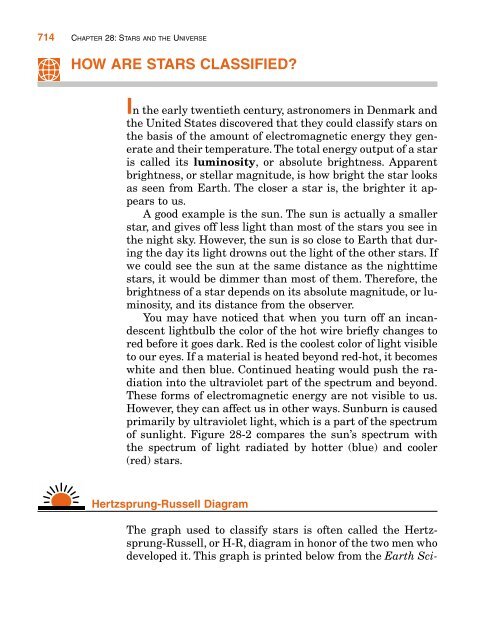Chapter 28 Stars and the Universe
Chapter 28 Stars and the Universe
Chapter 28 Stars and the Universe
You also want an ePaper? Increase the reach of your titles
YUMPU automatically turns print PDFs into web optimized ePapers that Google loves.
714 CHAPTER <strong>28</strong>: STARS AND THE UNIVERSE<br />
HOW ARE STARS CLASSIFIED?<br />
In <strong>the</strong> early twentieth century, astronomers in Denmark <strong>and</strong><br />
<strong>the</strong> United States discovered that <strong>the</strong>y could classify stars on<br />
<strong>the</strong> basis of <strong>the</strong> amount of electromagnetic energy <strong>the</strong>y generate<br />
<strong>and</strong> <strong>the</strong>ir temperature. The total energy output of a star<br />
is called its luminosity, or absolute brightness. Apparent<br />
brightness, or stellar magnitude, is how bright <strong>the</strong> star looks<br />
as seen from Earth. The closer a star is, <strong>the</strong> brighter it appears<br />
to us.<br />
A good example is <strong>the</strong> sun. The sun is actually a smaller<br />
star, <strong>and</strong> gives off less light than most of <strong>the</strong> stars you see in<br />
<strong>the</strong> night sky. However, <strong>the</strong> sun is so close to Earth that during<br />
<strong>the</strong> day its light drowns out <strong>the</strong> light of <strong>the</strong> o<strong>the</strong>r stars. If<br />
we could see <strong>the</strong> sun at <strong>the</strong> same distance as <strong>the</strong> nighttime<br />
stars, it would be dimmer than most of <strong>the</strong>m. Therefore, <strong>the</strong><br />
brightness of a star depends on its absolute magnitude, or luminosity,<br />
<strong>and</strong> its distance from <strong>the</strong> observer.<br />
You may have noticed that when you turn off an inc<strong>and</strong>escent<br />
lightbulb <strong>the</strong> color of <strong>the</strong> hot wire briefly changes to<br />
red before it goes dark. Red is <strong>the</strong> coolest color of light visible<br />
to our eyes. If a material is heated beyond red-hot, it becomes<br />
white <strong>and</strong> <strong>the</strong>n blue. Continued heating would push <strong>the</strong> radiation<br />
into <strong>the</strong> ultraviolet part of <strong>the</strong> spectrum <strong>and</strong> beyond.<br />
These forms of electromagnetic energy are not visible to us.<br />
However, <strong>the</strong>y can affect us in o<strong>the</strong>r ways. Sunburn is caused<br />
primarily by ultraviolet light, which is a part of <strong>the</strong> spectrum<br />
of sunlight. Figure <strong>28</strong>-2 compares <strong>the</strong> sun’s spectrum with<br />
<strong>the</strong> spectrum of light radiated by hotter (blue) <strong>and</strong> cooler<br />
(red) stars.<br />
Hertzsprung-Russell Diagram<br />
The graph used to classify stars is often called <strong>the</strong> Hertzsprung-Russell,<br />
or H-R, diagram in honor of <strong>the</strong> two men who<br />
developed it. This graph is printed below from <strong>the</strong> Earth Sci-

















